Strategic Analysis of Google LLC: Management, Leadership, and Strategy
VerifiedAdded on 2021/04/17
|9
|1791
|40
Report
AI Summary
This report provides a comprehensive analysis of Google LLC's strategic management, focusing on its mission and vision statements, leadership style, and strategic framework. The report evaluates Google's mission to organize the world's information and its vision to improve lives through its services. It highlights the company's transformational leadership style, emphasizing innovation and a bottom-up approach to strategy development. The analysis covers the strategies Google employs, such as acquiring information, protecting intellectual property, and fostering continuous learning. The report also examines Google's competitive strategies, including hiring top talent and developing new products and services to maintain its competitive edge in the dynamic technology landscape. The report concludes by summarizing the key aspects of Google's strategic management and leadership structure.
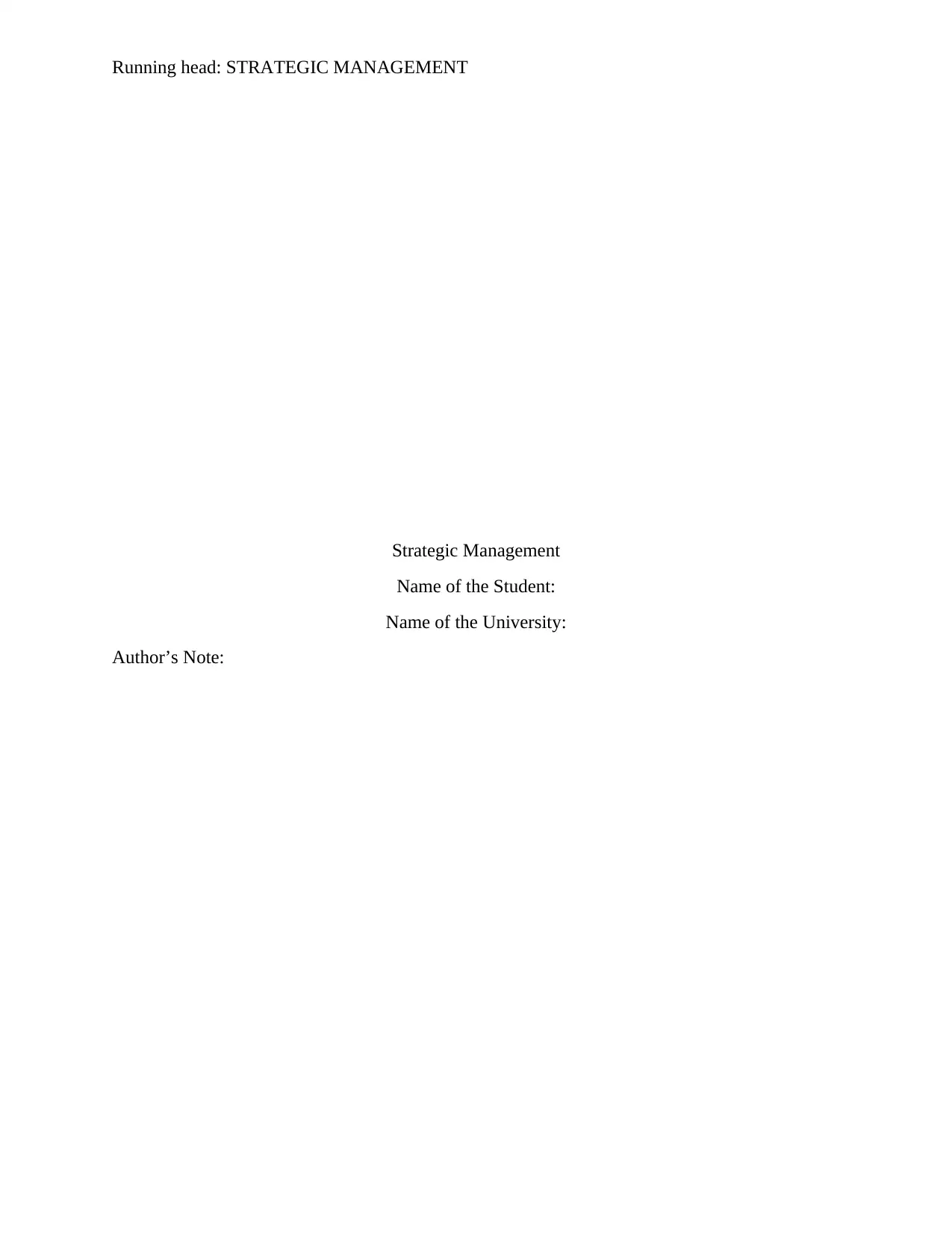
Running head: STRATEGIC MANAGEMENT
Strategic Management
Name of the Student:
Name of the University:
Author’s Note:
Strategic Management
Name of the Student:
Name of the University:
Author’s Note:
Paraphrase This Document
Need a fresh take? Get an instant paraphrase of this document with our AI Paraphraser
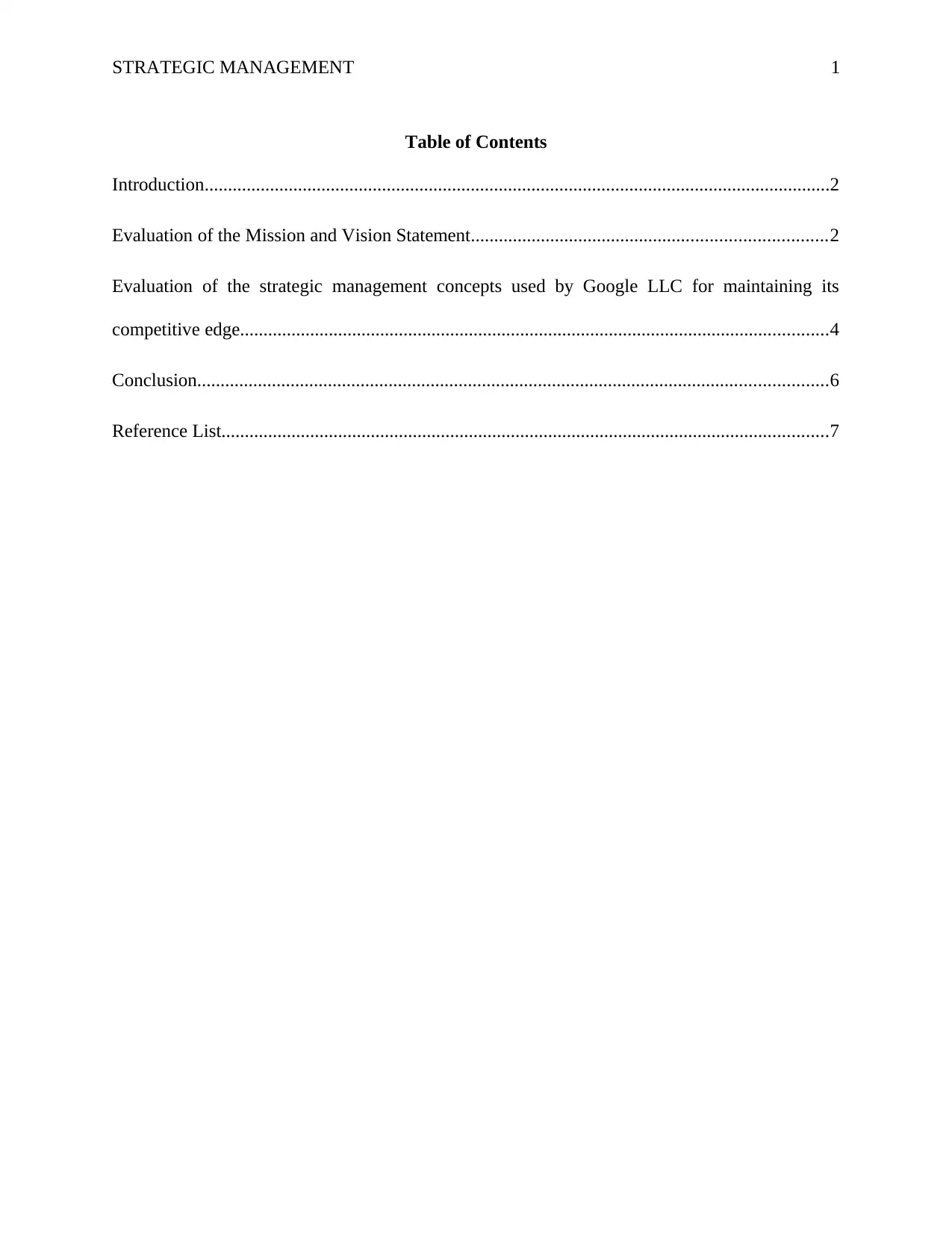
STRATEGIC MANAGEMENT 1
Table of Contents
Introduction......................................................................................................................................2
Evaluation of the Mission and Vision Statement............................................................................2
Evaluation of the strategic management concepts used by Google LLC for maintaining its
competitive edge..............................................................................................................................4
Conclusion.......................................................................................................................................6
Reference List..................................................................................................................................7
Table of Contents
Introduction......................................................................................................................................2
Evaluation of the Mission and Vision Statement............................................................................2
Evaluation of the strategic management concepts used by Google LLC for maintaining its
competitive edge..............................................................................................................................4
Conclusion.......................................................................................................................................6
Reference List..................................................................................................................................7
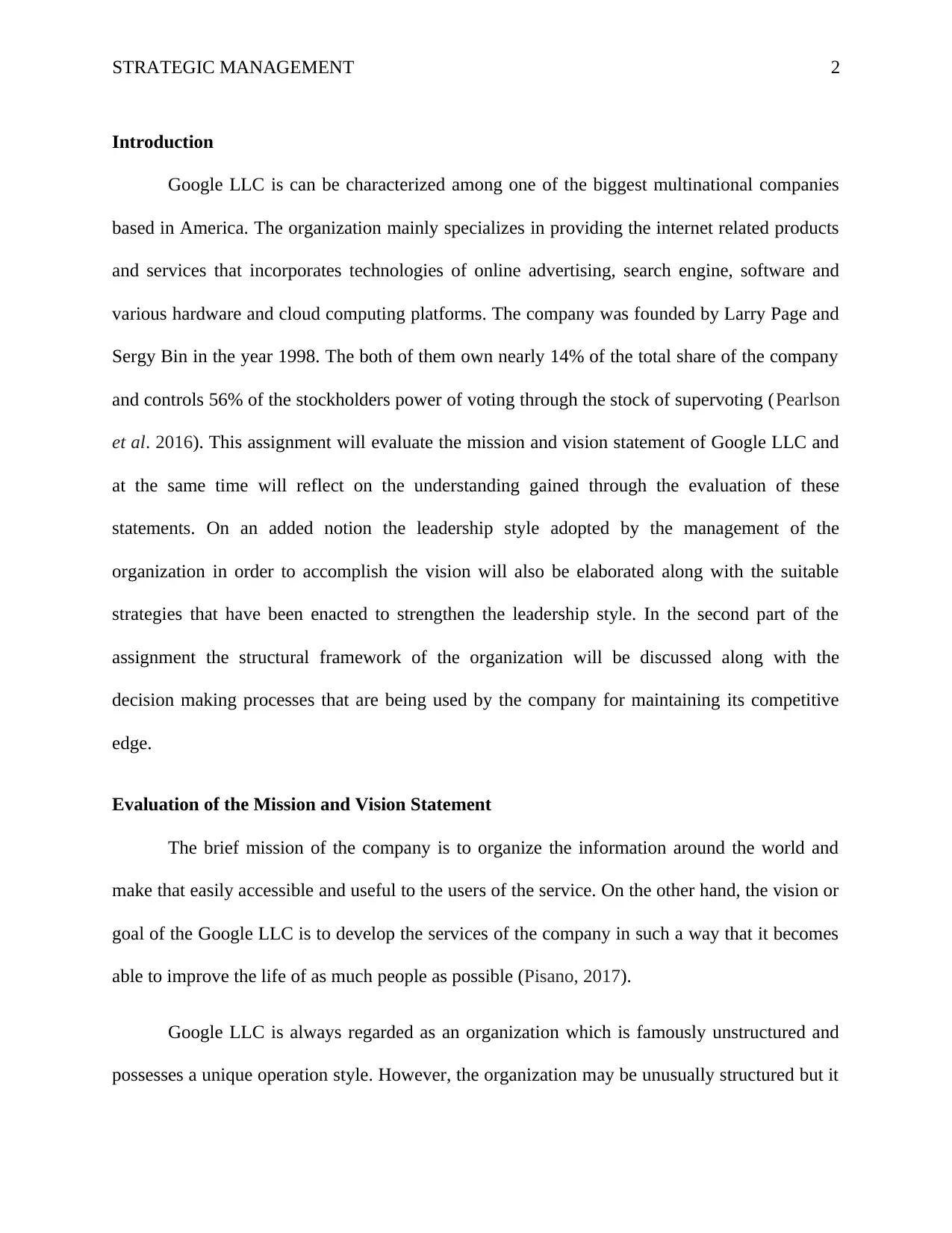
STRATEGIC MANAGEMENT 2
Introduction
Google LLC is can be characterized among one of the biggest multinational companies
based in America. The organization mainly specializes in providing the internet related products
and services that incorporates technologies of online advertising, search engine, software and
various hardware and cloud computing platforms. The company was founded by Larry Page and
Sergy Bin in the year 1998. The both of them own nearly 14% of the total share of the company
and controls 56% of the stockholders power of voting through the stock of supervoting (Pearlson
et al. 2016). This assignment will evaluate the mission and vision statement of Google LLC and
at the same time will reflect on the understanding gained through the evaluation of these
statements. On an added notion the leadership style adopted by the management of the
organization in order to accomplish the vision will also be elaborated along with the suitable
strategies that have been enacted to strengthen the leadership style. In the second part of the
assignment the structural framework of the organization will be discussed along with the
decision making processes that are being used by the company for maintaining its competitive
edge.
Evaluation of the Mission and Vision Statement
The brief mission of the company is to organize the information around the world and
make that easily accessible and useful to the users of the service. On the other hand, the vision or
goal of the Google LLC is to develop the services of the company in such a way that it becomes
able to improve the life of as much people as possible (Pisano, 2017).
Google LLC is always regarded as an organization which is famously unstructured and
possesses a unique operation style. However, the organization may be unusually structured but it
Introduction
Google LLC is can be characterized among one of the biggest multinational companies
based in America. The organization mainly specializes in providing the internet related products
and services that incorporates technologies of online advertising, search engine, software and
various hardware and cloud computing platforms. The company was founded by Larry Page and
Sergy Bin in the year 1998. The both of them own nearly 14% of the total share of the company
and controls 56% of the stockholders power of voting through the stock of supervoting (Pearlson
et al. 2016). This assignment will evaluate the mission and vision statement of Google LLC and
at the same time will reflect on the understanding gained through the evaluation of these
statements. On an added notion the leadership style adopted by the management of the
organization in order to accomplish the vision will also be elaborated along with the suitable
strategies that have been enacted to strengthen the leadership style. In the second part of the
assignment the structural framework of the organization will be discussed along with the
decision making processes that are being used by the company for maintaining its competitive
edge.
Evaluation of the Mission and Vision Statement
The brief mission of the company is to organize the information around the world and
make that easily accessible and useful to the users of the service. On the other hand, the vision or
goal of the Google LLC is to develop the services of the company in such a way that it becomes
able to improve the life of as much people as possible (Pisano, 2017).
Google LLC is always regarded as an organization which is famously unstructured and
possesses a unique operation style. However, the organization may be unusually structured but it
⊘ This is a preview!⊘
Do you want full access?
Subscribe today to unlock all pages.

Trusted by 1+ million students worldwide
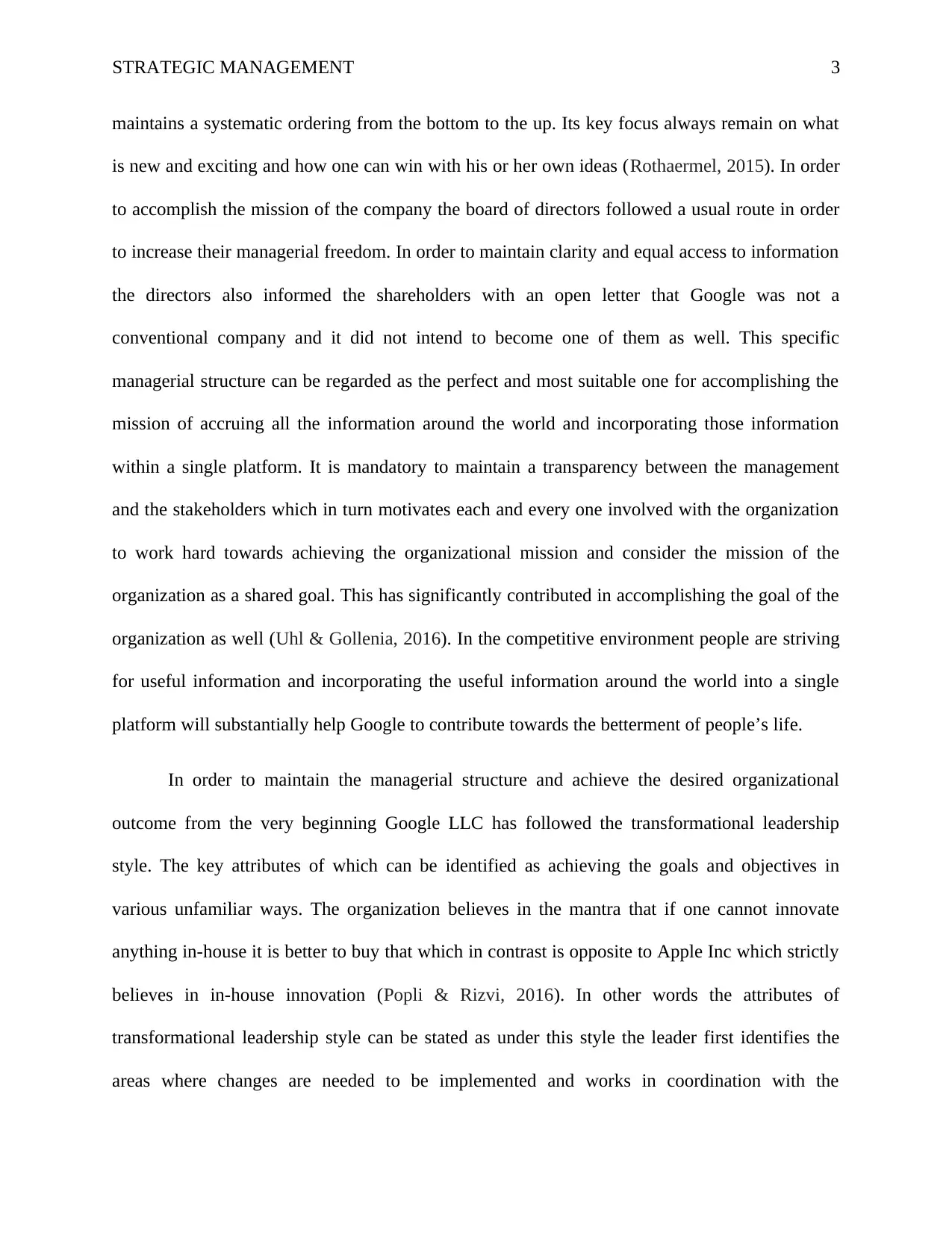
STRATEGIC MANAGEMENT 3
maintains a systematic ordering from the bottom to the up. Its key focus always remain on what
is new and exciting and how one can win with his or her own ideas (Rothaermel, 2015). In order
to accomplish the mission of the company the board of directors followed a usual route in order
to increase their managerial freedom. In order to maintain clarity and equal access to information
the directors also informed the shareholders with an open letter that Google was not a
conventional company and it did not intend to become one of them as well. This specific
managerial structure can be regarded as the perfect and most suitable one for accomplishing the
mission of accruing all the information around the world and incorporating those information
within a single platform. It is mandatory to maintain a transparency between the management
and the stakeholders which in turn motivates each and every one involved with the organization
to work hard towards achieving the organizational mission and consider the mission of the
organization as a shared goal. This has significantly contributed in accomplishing the goal of the
organization as well (Uhl & Gollenia, 2016). In the competitive environment people are striving
for useful information and incorporating the useful information around the world into a single
platform will substantially help Google to contribute towards the betterment of people’s life.
In order to maintain the managerial structure and achieve the desired organizational
outcome from the very beginning Google LLC has followed the transformational leadership
style. The key attributes of which can be identified as achieving the goals and objectives in
various unfamiliar ways. The organization believes in the mantra that if one cannot innovate
anything in-house it is better to buy that which in contrast is opposite to Apple Inc which strictly
believes in in-house innovation (Popli & Rizvi, 2016). In other words the attributes of
transformational leadership style can be stated as under this style the leader first identifies the
areas where changes are needed to be implemented and works in coordination with the
maintains a systematic ordering from the bottom to the up. Its key focus always remain on what
is new and exciting and how one can win with his or her own ideas (Rothaermel, 2015). In order
to accomplish the mission of the company the board of directors followed a usual route in order
to increase their managerial freedom. In order to maintain clarity and equal access to information
the directors also informed the shareholders with an open letter that Google was not a
conventional company and it did not intend to become one of them as well. This specific
managerial structure can be regarded as the perfect and most suitable one for accomplishing the
mission of accruing all the information around the world and incorporating those information
within a single platform. It is mandatory to maintain a transparency between the management
and the stakeholders which in turn motivates each and every one involved with the organization
to work hard towards achieving the organizational mission and consider the mission of the
organization as a shared goal. This has significantly contributed in accomplishing the goal of the
organization as well (Uhl & Gollenia, 2016). In the competitive environment people are striving
for useful information and incorporating the useful information around the world into a single
platform will substantially help Google to contribute towards the betterment of people’s life.
In order to maintain the managerial structure and achieve the desired organizational
outcome from the very beginning Google LLC has followed the transformational leadership
style. The key attributes of which can be identified as achieving the goals and objectives in
various unfamiliar ways. The organization believes in the mantra that if one cannot innovate
anything in-house it is better to buy that which in contrast is opposite to Apple Inc which strictly
believes in in-house innovation (Popli & Rizvi, 2016). In other words the attributes of
transformational leadership style can be stated as under this style the leader first identifies the
areas where changes are needed to be implemented and works in coordination with the
Paraphrase This Document
Need a fresh take? Get an instant paraphrase of this document with our AI Paraphraser

STRATEGIC MANAGEMENT 4
employees together at the same time through inspiring and motivating them the leader brings
about those changes.
In order to substantiate the leadership style Google has also enacted a few strategies
which helps to strengthen the leadership and management structure of the organization. A few
key strategies can be stated as follows,
People who work with the organization are motivated in such a way that they strive to
support the organization in retaining the position of “King of search”.
Google considers a two way relationship between technology and strategy. Strategy is
considered ass technology and vice versa (Yahaya and Ebrahim, 2016).
The core strategy of Google is to acquire information, record the information, analyze it
and applying the inner framework of the organization helps it to achieve the desired
outcome.
One of the most noteworthy strategy that supports the managerial framework is that the
organization has never considered itself as a search engine it always believed that it is
working on organizing available information throughout the world and making them
useful and accessible to the people (Zareen et al. 2015). This in turn enabled its managers
of workers to believe that that are working towards a noble purpose.
Evaluation of the strategic management concepts used by Google LLC for maintaining its
competitive edge
The key for maintaining the strategic management structure of Google is that its bottom
up structured here all the employees from all the levels play an important role in the process of
strategy designing.
employees together at the same time through inspiring and motivating them the leader brings
about those changes.
In order to substantiate the leadership style Google has also enacted a few strategies
which helps to strengthen the leadership and management structure of the organization. A few
key strategies can be stated as follows,
People who work with the organization are motivated in such a way that they strive to
support the organization in retaining the position of “King of search”.
Google considers a two way relationship between technology and strategy. Strategy is
considered ass technology and vice versa (Yahaya and Ebrahim, 2016).
The core strategy of Google is to acquire information, record the information, analyze it
and applying the inner framework of the organization helps it to achieve the desired
outcome.
One of the most noteworthy strategy that supports the managerial framework is that the
organization has never considered itself as a search engine it always believed that it is
working on organizing available information throughout the world and making them
useful and accessible to the people (Zareen et al. 2015). This in turn enabled its managers
of workers to believe that that are working towards a noble purpose.
Evaluation of the strategic management concepts used by Google LLC for maintaining its
competitive edge
The key for maintaining the strategic management structure of Google is that its bottom
up structured here all the employees from all the levels play an important role in the process of
strategy designing.
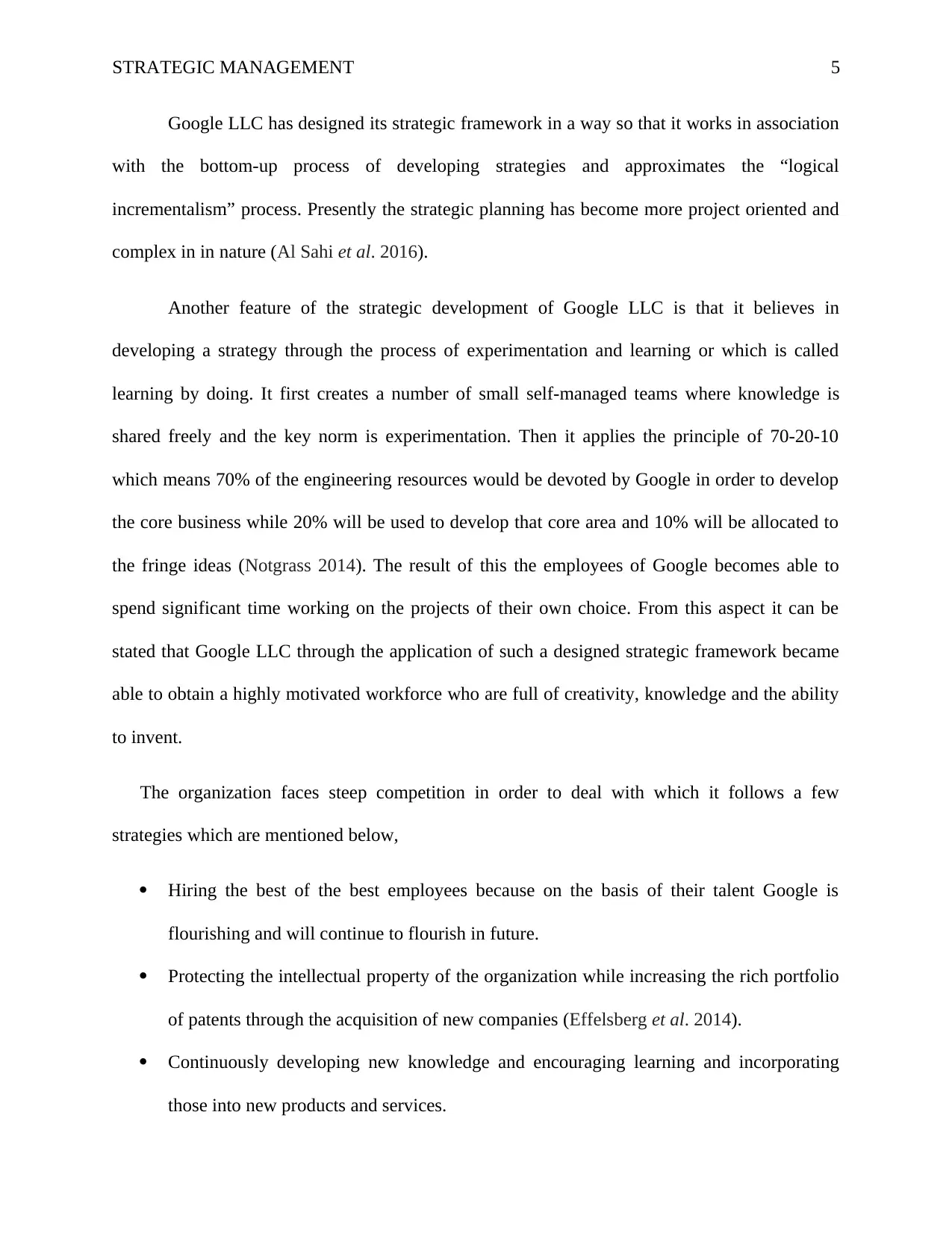
STRATEGIC MANAGEMENT 5
Google LLC has designed its strategic framework in a way so that it works in association
with the bottom-up process of developing strategies and approximates the “logical
incrementalism” process. Presently the strategic planning has become more project oriented and
complex in in nature (Al Sahi et al. 2016).
Another feature of the strategic development of Google LLC is that it believes in
developing a strategy through the process of experimentation and learning or which is called
learning by doing. It first creates a number of small self-managed teams where knowledge is
shared freely and the key norm is experimentation. Then it applies the principle of 70-20-10
which means 70% of the engineering resources would be devoted by Google in order to develop
the core business while 20% will be used to develop that core area and 10% will be allocated to
the fringe ideas (Notgrass 2014). The result of this the employees of Google becomes able to
spend significant time working on the projects of their own choice. From this aspect it can be
stated that Google LLC through the application of such a designed strategic framework became
able to obtain a highly motivated workforce who are full of creativity, knowledge and the ability
to invent.
The organization faces steep competition in order to deal with which it follows a few
strategies which are mentioned below,
Hiring the best of the best employees because on the basis of their talent Google is
flourishing and will continue to flourish in future.
Protecting the intellectual property of the organization while increasing the rich portfolio
of patents through the acquisition of new companies (Effelsberg et al. 2014).
Continuously developing new knowledge and encouraging learning and incorporating
those into new products and services.
Google LLC has designed its strategic framework in a way so that it works in association
with the bottom-up process of developing strategies and approximates the “logical
incrementalism” process. Presently the strategic planning has become more project oriented and
complex in in nature (Al Sahi et al. 2016).
Another feature of the strategic development of Google LLC is that it believes in
developing a strategy through the process of experimentation and learning or which is called
learning by doing. It first creates a number of small self-managed teams where knowledge is
shared freely and the key norm is experimentation. Then it applies the principle of 70-20-10
which means 70% of the engineering resources would be devoted by Google in order to develop
the core business while 20% will be used to develop that core area and 10% will be allocated to
the fringe ideas (Notgrass 2014). The result of this the employees of Google becomes able to
spend significant time working on the projects of their own choice. From this aspect it can be
stated that Google LLC through the application of such a designed strategic framework became
able to obtain a highly motivated workforce who are full of creativity, knowledge and the ability
to invent.
The organization faces steep competition in order to deal with which it follows a few
strategies which are mentioned below,
Hiring the best of the best employees because on the basis of their talent Google is
flourishing and will continue to flourish in future.
Protecting the intellectual property of the organization while increasing the rich portfolio
of patents through the acquisition of new companies (Effelsberg et al. 2014).
Continuously developing new knowledge and encouraging learning and incorporating
those into new products and services.
⊘ This is a preview!⊘
Do you want full access?
Subscribe today to unlock all pages.

Trusted by 1+ million students worldwide
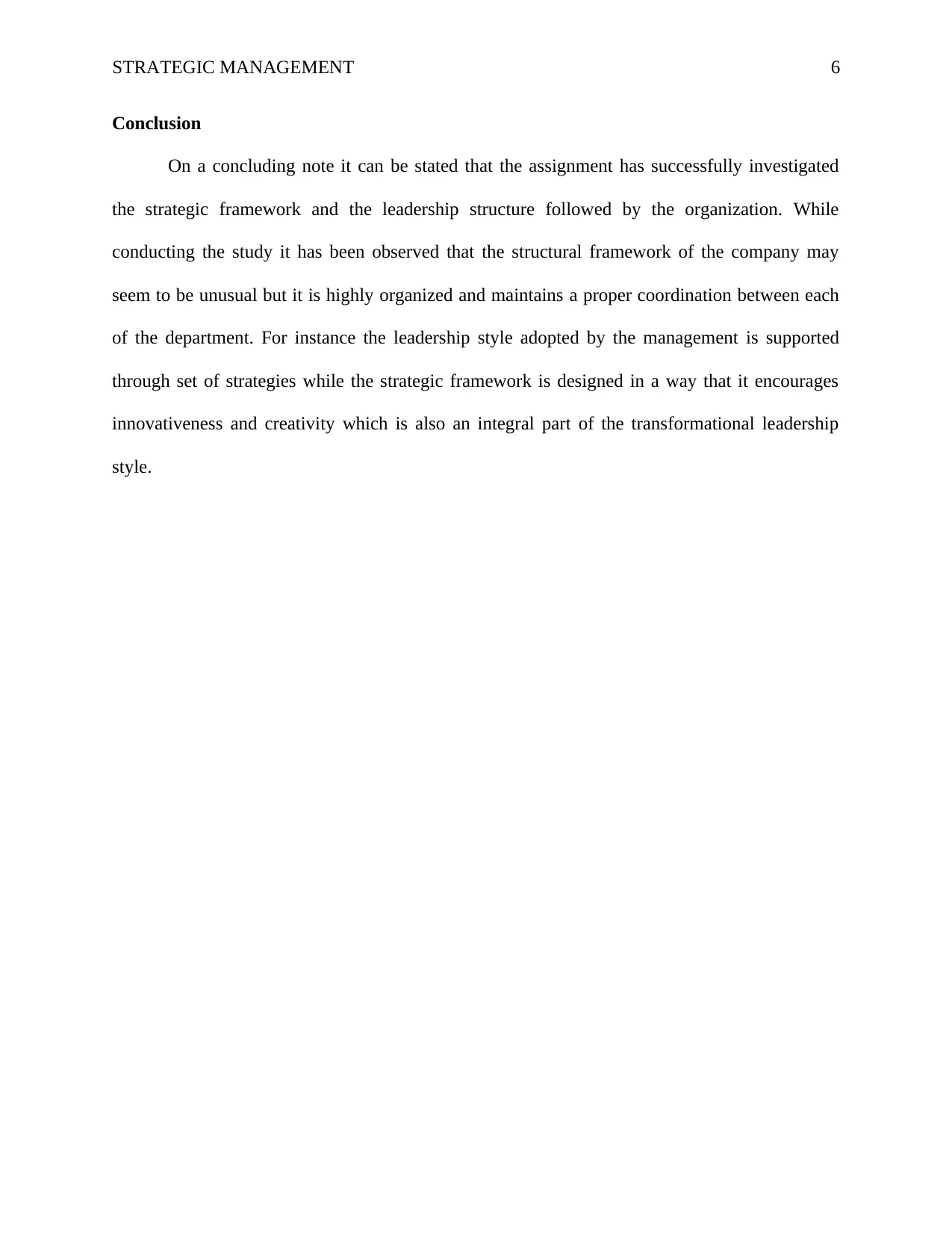
STRATEGIC MANAGEMENT 6
Conclusion
On a concluding note it can be stated that the assignment has successfully investigated
the strategic framework and the leadership structure followed by the organization. While
conducting the study it has been observed that the structural framework of the company may
seem to be unusual but it is highly organized and maintains a proper coordination between each
of the department. For instance the leadership style adopted by the management is supported
through set of strategies while the strategic framework is designed in a way that it encourages
innovativeness and creativity which is also an integral part of the transformational leadership
style.
Conclusion
On a concluding note it can be stated that the assignment has successfully investigated
the strategic framework and the leadership structure followed by the organization. While
conducting the study it has been observed that the structural framework of the company may
seem to be unusual but it is highly organized and maintains a proper coordination between each
of the department. For instance the leadership style adopted by the management is supported
through set of strategies while the strategic framework is designed in a way that it encourages
innovativeness and creativity which is also an integral part of the transformational leadership
style.
Paraphrase This Document
Need a fresh take? Get an instant paraphrase of this document with our AI Paraphraser
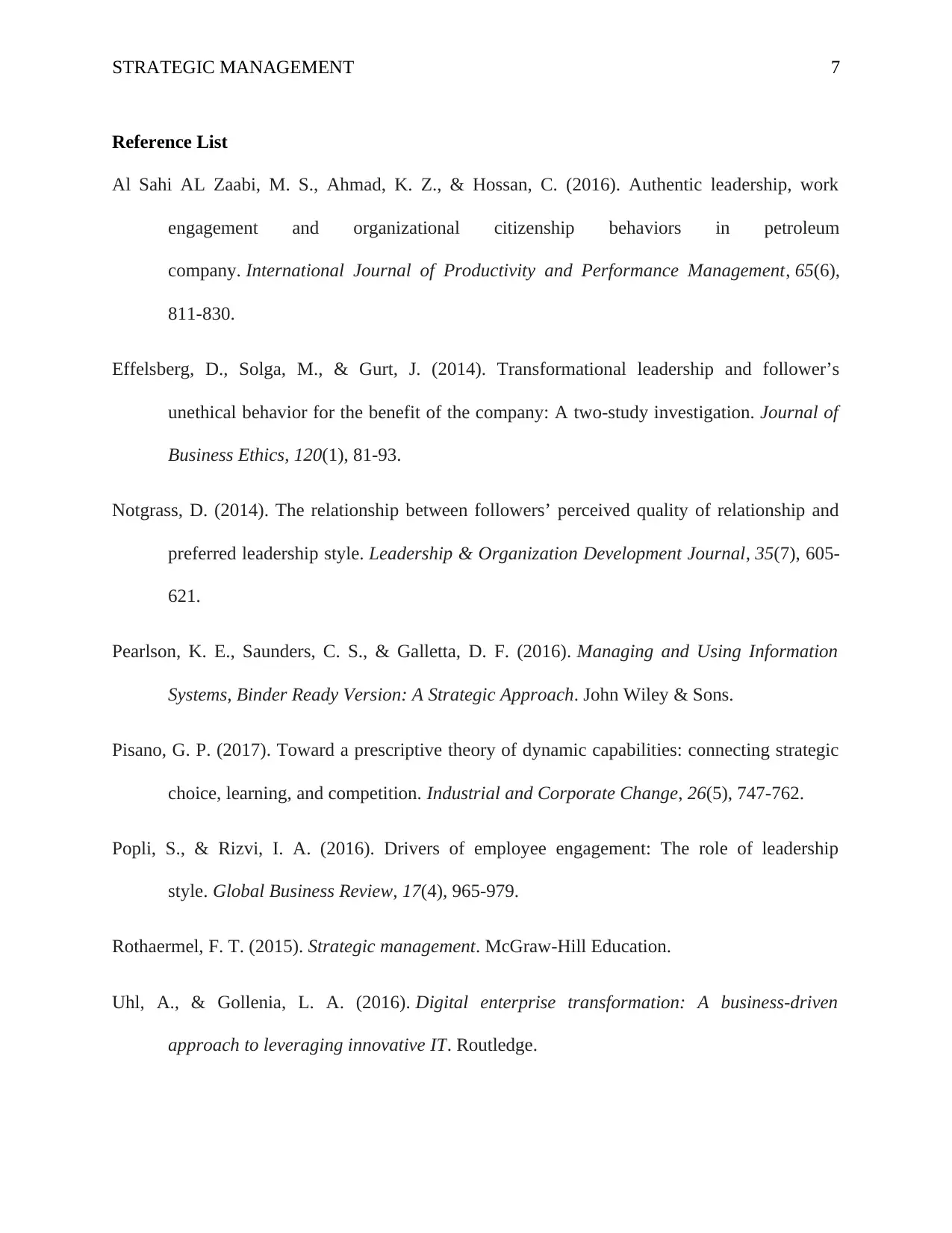
STRATEGIC MANAGEMENT 7
Reference List
Al Sahi AL Zaabi, M. S., Ahmad, K. Z., & Hossan, C. (2016). Authentic leadership, work
engagement and organizational citizenship behaviors in petroleum
company. International Journal of Productivity and Performance Management, 65(6),
811-830.
Effelsberg, D., Solga, M., & Gurt, J. (2014). Transformational leadership and follower’s
unethical behavior for the benefit of the company: A two-study investigation. Journal of
Business Ethics, 120(1), 81-93.
Notgrass, D. (2014). The relationship between followers’ perceived quality of relationship and
preferred leadership style. Leadership & Organization Development Journal, 35(7), 605-
621.
Pearlson, K. E., Saunders, C. S., & Galletta, D. F. (2016). Managing and Using Information
Systems, Binder Ready Version: A Strategic Approach. John Wiley & Sons.
Pisano, G. P. (2017). Toward a prescriptive theory of dynamic capabilities: connecting strategic
choice, learning, and competition. Industrial and Corporate Change, 26(5), 747-762.
Popli, S., & Rizvi, I. A. (2016). Drivers of employee engagement: The role of leadership
style. Global Business Review, 17(4), 965-979.
Rothaermel, F. T. (2015). Strategic management. McGraw-Hill Education.
Uhl, A., & Gollenia, L. A. (2016). Digital enterprise transformation: A business-driven
approach to leveraging innovative IT. Routledge.
Reference List
Al Sahi AL Zaabi, M. S., Ahmad, K. Z., & Hossan, C. (2016). Authentic leadership, work
engagement and organizational citizenship behaviors in petroleum
company. International Journal of Productivity and Performance Management, 65(6),
811-830.
Effelsberg, D., Solga, M., & Gurt, J. (2014). Transformational leadership and follower’s
unethical behavior for the benefit of the company: A two-study investigation. Journal of
Business Ethics, 120(1), 81-93.
Notgrass, D. (2014). The relationship between followers’ perceived quality of relationship and
preferred leadership style. Leadership & Organization Development Journal, 35(7), 605-
621.
Pearlson, K. E., Saunders, C. S., & Galletta, D. F. (2016). Managing and Using Information
Systems, Binder Ready Version: A Strategic Approach. John Wiley & Sons.
Pisano, G. P. (2017). Toward a prescriptive theory of dynamic capabilities: connecting strategic
choice, learning, and competition. Industrial and Corporate Change, 26(5), 747-762.
Popli, S., & Rizvi, I. A. (2016). Drivers of employee engagement: The role of leadership
style. Global Business Review, 17(4), 965-979.
Rothaermel, F. T. (2015). Strategic management. McGraw-Hill Education.
Uhl, A., & Gollenia, L. A. (2016). Digital enterprise transformation: A business-driven
approach to leveraging innovative IT. Routledge.
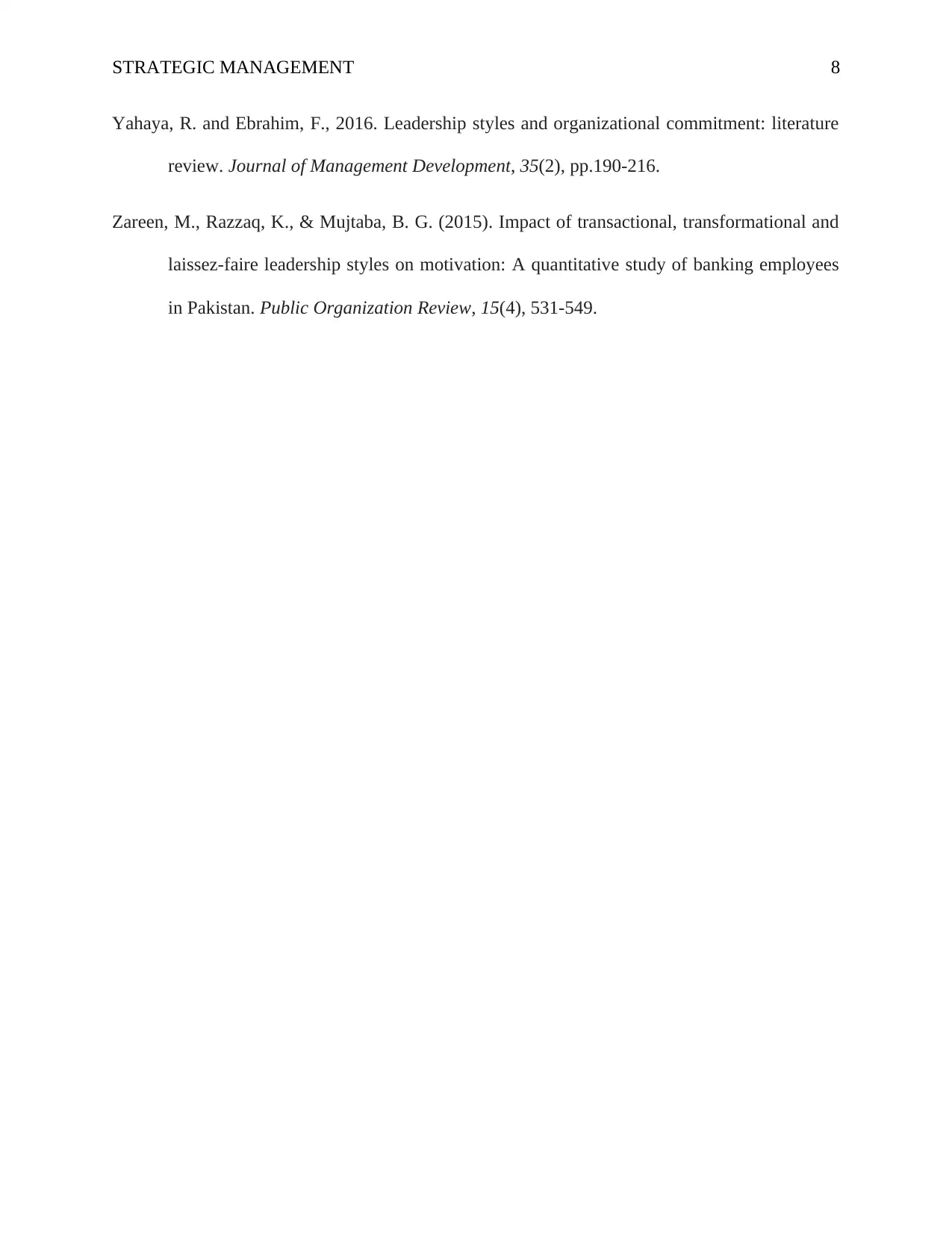
STRATEGIC MANAGEMENT 8
Yahaya, R. and Ebrahim, F., 2016. Leadership styles and organizational commitment: literature
review. Journal of Management Development, 35(2), pp.190-216.
Zareen, M., Razzaq, K., & Mujtaba, B. G. (2015). Impact of transactional, transformational and
laissez-faire leadership styles on motivation: A quantitative study of banking employees
in Pakistan. Public Organization Review, 15(4), 531-549.
Yahaya, R. and Ebrahim, F., 2016. Leadership styles and organizational commitment: literature
review. Journal of Management Development, 35(2), pp.190-216.
Zareen, M., Razzaq, K., & Mujtaba, B. G. (2015). Impact of transactional, transformational and
laissez-faire leadership styles on motivation: A quantitative study of banking employees
in Pakistan. Public Organization Review, 15(4), 531-549.
⊘ This is a preview!⊘
Do you want full access?
Subscribe today to unlock all pages.

Trusted by 1+ million students worldwide
1 out of 9
Related Documents
Your All-in-One AI-Powered Toolkit for Academic Success.
+13062052269
info@desklib.com
Available 24*7 on WhatsApp / Email
![[object Object]](/_next/static/media/star-bottom.7253800d.svg)
Unlock your academic potential
Copyright © 2020–2025 A2Z Services. All Rights Reserved. Developed and managed by ZUCOL.





